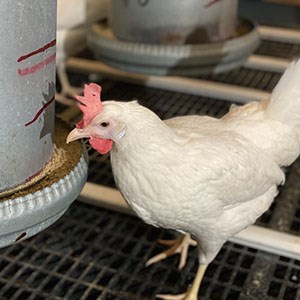Facts:
The project runs 2022-2025 and is financed by Lantmännens Research Foundation.

The aim of the suggested project is to evaluate if ammonia volatilization from the litter in laying hen facilities can be lowered by adjusted levels of crude protein, amino acids and insoluble fibre in the feed.
Within Swedish egg production, high ammonia levels are considered as the major environmental challenge. The issue with ammonia is greatest in aviaries, where the manure stays in the litter. For many egg producers with these systems, it is a problem to meet the limit of 10 ppm ammonia especially during fall and winter. Ammonia is produced when bacteria degrades nitrogen compounds in the manure. High level of crude protein in the feed and thereby nitrogen in the manure increase the risk of ammonia formation. Fibre in the feed might however reduce the ammonia volatilization by increasing the microbial activity so more nitrogen is excreted as microbial more stable protein, and in addition stimulates production of volatile fatty acids, which can reduce the pH of manure.
The current project will be performed in two steps. In the first step the levels of soluble and insoluble fibre in Swedish standard feeds for laying hens will be investigated. In the second step, in a feeding trial with laying hens, the effects on ammonia volatilization, egg production, mortality and feather coverage of lowered crude protein levels together with addition of synthetic amino acids and insoluble fibre will be investigated.
As high levels of ammonia is both a social and environmental sustainability issue in egg production preventive measures is urgently needed. The measures suggested in current project, could if proven efficient be implemented immediately.
Emma Ivarsson (HUV, Swedish University of Agricultural Sciences) Emma.Ivarsson@slu.se
Helena Wall (HUV, Swedish University of Agricultural Sciences)
Kristina Mjöfors (RISE Research Institutes of Sweden AB)
Malin Alm (Vreta Kluster)
Maja Hoffer (Lantmännen Lantbruk)
Kerstin Sigfridson (Lantmännens forskningsstiftelse)
The project runs 2022-2025 and is financed by Lantmännens Research Foundation.